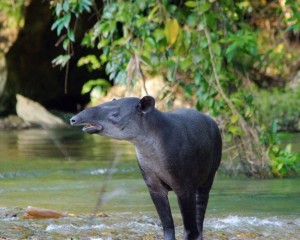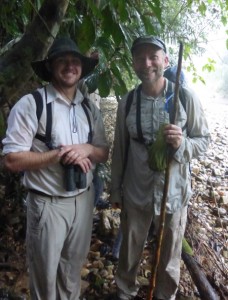Student Spotlight
BFREE Program Coordinator, Tyler Sanville, Interviews UNC Wilmington Graduate Student, James Abbott
Tyler: Hi James, can you tell us a little bit about yourself?
James: I’m James Abbott, originally from Yorktown, VA but I have been in Wilmington, NC since 2008. I am a second year graduate student in the Environmental Studies Department at UNCW concentrating in Environmental Education. My undergraduate background from UNCW is in Conservation Biology and Wildlife, specifically birds. I would like to use my research into the conservation of threatened habitats and species as a means to educate and connect people to our environment, our role in that environment, and the positive impact we can have on our environment.
Tyler: How did you find out about BFREE and when did you visit?
James: I began volunteering with Dr. Rotenberg’s painted bunting banding program in 2010 as an undergraduate and learned of his work with harpy eagle in Belize. In 2011, I had the chance to visit Belize with Dr. Rotenberg for the first time, though not BFREE. I heard a lot about BFREE that trip from both Dr. Rotenberg and Judy Dourson (Director of Educational Programs at BFREE from 2007-2012) and told myself that if I got the chance I would try to come back to Belize to visit BFREE.
I graduated and worked as a threatened and endangered species biologist on a Marine Corps base near Wilmington, Camp Lejeune. I left that job to pursue graduate school and it just so happened that Dr. Rotenberg was running his Belize spring break class, the very same I had gone on back in 2011, and this time the class was traveling to BFREE. I couldn’t pass it up. I don’t think Dr. Rotenberg would have let me miss it anyway! That visit to BFREE was for a week in March 2015. The more recent expedition to search for the harpy eagle was over the New Year’s holiday for ten days.
Tyler: What did you do while you were at the BFREE field station?
James: This most recent trip to BFREE was an expedition into the Bladen Nature Reserve up to the harpy eagle nest to see if the birds were nesting or were in the area. We spent one night at BFREE then hiked up into the reserve and spent five days up near the nest. A team of people containing researchers, rangers, harpy experts, BFREE Avian Technicians William Garcia and Gato Pop, and finally BFREE Director Jacob Marlin made the all-day hike up the Bladen River. We did not find the harpy eagles on the nest so we spent the remaining days looking for the birds in nearby areas and from observation points on ridge lines. We returned to BFREE and conducted an unofficial Christmas Bird Count on the BFREE property.
Tyler: Do you have a favorite moment from your trip?
James: My favorite moments at BFREE are mornings camping by the river crossing in a hammock and listening to the river and the rainforest wake up; it is a surreal and immersive experience. My favorite activity at BFREE is climbing up to the top of the observation tower to see the 360 degree view of the canopy, the mountains, and the all of the birds and monkeys around you – all at eye level.
Tyler: Is there anything that you miss since leaving the BFREE field station?
James: I think the two things I miss the most about BFREE are the camaraderie between the visiting groups and the staff at the station. Everyone is very welcoming and it creates a great atmosphere for learning and research. The second thing I miss is that special kind of peace that comes from a total disconnect of contact from all of the information and technology that clouds up everyday life in the states. It really makes you appreciate the natural world and your real part in it.
Tyler: Do you have any advice for someone visiting the BFREE field station?
James:
- Welcome the full experience – the field station and the rainforest it helps protect are truly special.
- Realize how liberating it is to be BFREE and how much more natural you feel.
- Talk to the staff and any other people visiting the station. You will get a greater understanding and appreciation of life in Belize. Other visiting researchers and groups have a wealth of knowledge and experience in many different fields so it is a great place learn.
- Embrace long pants and shirts, howler monkey wake up calls, and bring an umbrella.



Trackbacks & Pingbacks
[…] James Abbott, full time educator at the James River Association, led the group. His combination of expert insights and detailed knowledge about the intricacies of every bird and bird behavior in Hampton Roads combined with enthusiasm, confidence, and humor made him a perfect trip leader. We learned that James had even been on National Geographic funded expeditions to unexplored caves and sinkholes in the jungles of Belize where the team discovered four new species of snail; you can read more about the trip at the Belize Foundation For Research & Environmental Education website.: https://www.bfreebz.org/student-spotlight/ […]
Leave a Reply
Want to join the discussion?Feel free to contribute!